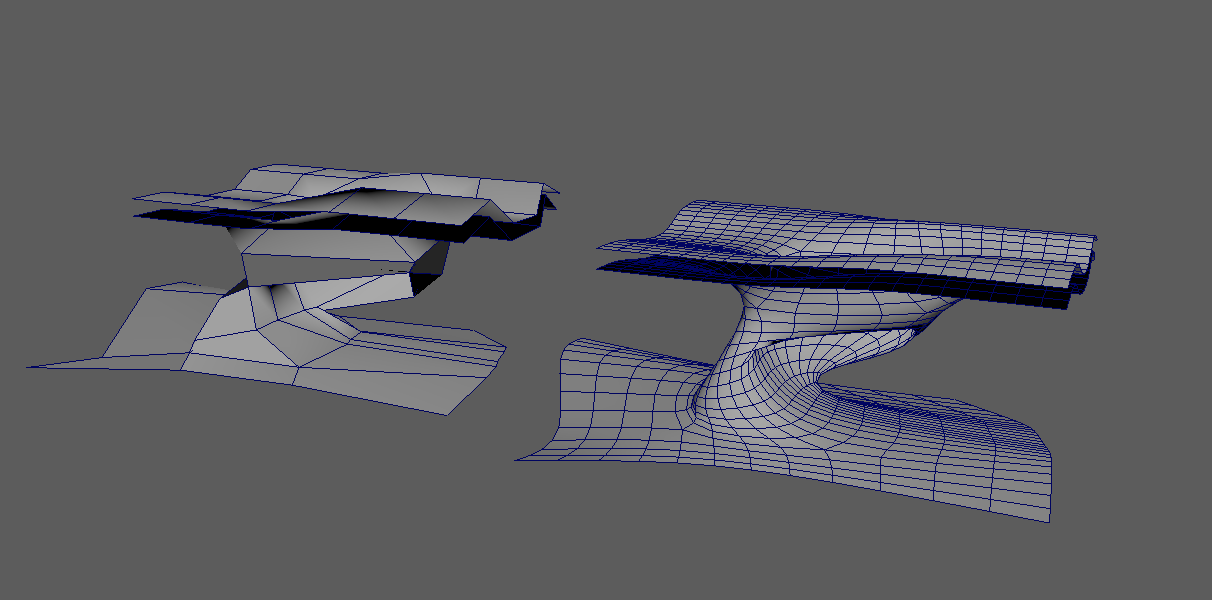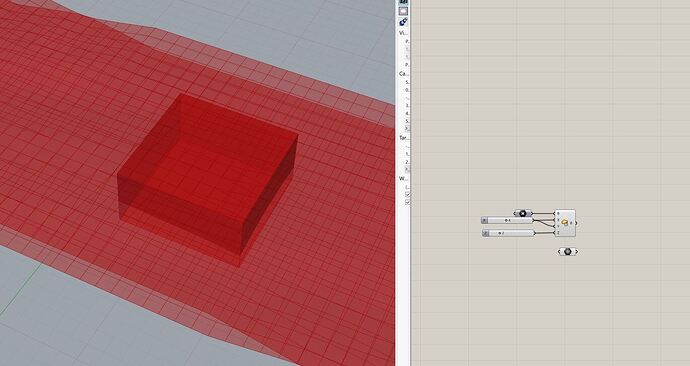Here’s my guess at the input coarse mesh.
Making these starting meshes for more complex topology just takes a bit of practice.
mwb_mesh.gh (7.3 KB)
Unfortunately, I still have not found a way how to make a swirl opening between two surfaces.
As shown in this image, the swirl connects to the floors through openings.
Mr. Robert, the maker of this design made this probably by hand. However, I am looking for a way to do it parametrically.
Starting with two surfaces. I can make a hole in the surface and then bridge the surfaces somehow. However, it does connect the floors.
This loops surfaces, but does not connect floors as in Mr. Robert’s principle.
Then, I was thinking about agents flowing over the surfaces and falling in a hole towards the other surface.
Maybe, this puzzle is unsolvable.
I cannot find a trick to solve the puzzle.
Do you might have an idea about that?
@HS_Kim Do you might have an idea?
This loops surfaces, but does not connect floors as in Mr. Robert’s principle.
It does, remove a face for exiting and add some twisting.
Not at all by hand. When I did deep search on Robert Stuart Smith design work’s. He explains that, “The form and character of the opera house (one of his design) is arrived at through a formative process of self-organisation. A complex topological surface emerges from the self-organisation of a swarm system. The swarm is tasked to operate topologically, through the local interaction of agent based surface nodes and their individually assigned event triggered behaviours. The methodology situates formation as a series of local and interrelated events, that allow for a range of surface conditions to arise and trigger further change. Inspired by the graphic topological transformations outlined in Stuart Pivar’s On the origin of form: Evolution by self-organisation”.
For this design he says, “The relief is designed partially through generative multi-agent computational processes executed on a computer, and partially through algorithms executed in real-time directly within the fabrication process.”


For this project he explains,“This form was generated through a swarm-based algorithm - developed from the turbulent and chaotic systems underlying cloud formation. This non-linear algorithmic methodology structured a relationship between the interior gallery programs, exterior form and facade articulation that would allow for very different readings of the project. These perceptual differences are created by the chaotic and turbulent nature of the swarm organisation, producing fractal affects of flow. The cloud swarm formation wraps the gallery spaces while providing light to the podium level exterior spaces through topological manifolds. This same organisation generated the glazing structure and glass facade panelisation. This behavioural system generates form, pattern and affect that ties the podium and cloud together within a single process - intrinsically relating object and field.”
Another project of Robert Stuart Smith.
After going through his whole website, articles, and his works. According to me MR. Robert use Swarm based algorithms to generate these type forms with voids to his design.
All these resources are from: Robert Stuart Smith Website and Vimeo.
I don’t much about Swarm based algorithms some who know’s better about this can help you better.
But in grasshopper you use this plugin for Swarm intelligence.
Quelea Plugin @ForestOwl
Weaverbird plugin
Your mesh is horrible, there are some self intersection.
It you can take care of that Catmull&Clark could be a good way to make it organic.
If you are just doing one building, stay in Rhino and make a good mesh by hand. Then SubD (with Rhino 7) or Mesh + Catmull&Clark (Rh6+GH1)
Yes, I know WB, and my mesh is not horrible… it is just connected to the other mesh. There is no self intersection for so far I can find.
I tried Weaverbird already, but it makes it look like this. Or is that what you meant I should make to make it more organic?
My bad ! Organic is smooth, so what do you don’t like after Catmull&Clark ? You could play with the S option if you want to keep edges/corber fixed.
What did you expect?

I should maybe twist something and more faces, where after I can remove the faces and twist everything, and then smooth everything. 
That is not the same topology as you have in gh, I’ve sent you in pm how that should look, it should double back on itself which also makes a thickness. Look at the file i sent you, it is clear what you have is not the same.
Twist Connect.3dm (185.5 KB)
Yes, I know it is not the same topology, but I am trying to make something similar to “that” related to the previous shown references of Robert’s design.
I am trying to do it with this mesh, within this set box boundry.
Twisting it or something and then removing some faces somehow to smooth it and get a something similar result like as your given example.
problem loophole 02.gh (61.5 KB)
What you have:
What you are missing:
The mesh needs to double back on itself for that topology. That is what my mesh is doing.
Yes, I understand that, I am now trying to do something similar in grasshopper.
I was thinking about cutting and then rolling it partly inwards or make some extra tube.
I find it difficult to make something like it in grasshopper.
But, I might need some more time to come closer to it. 
@HS_Kim Do you might know how to relax the mesh from the mesh edges similar you did in an older post?
problem relax mesh 00.gh (13.1 KB)
I try to find a way to do it without Kangeroo. Then I can do things with Anemone.

















